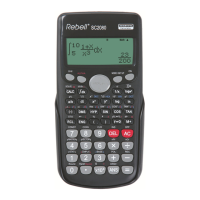Σx
2
y
[3](SUM)[7] Suma of pair (x
2
• y) variables x–y.
n
[4](VAR)[1] Number of entered x–y values.
[4](VAR)[2] Average of x or y values.
[4](VAR)[5]
xs
n–1
[4](VAR)[4] Sample standard deviation of x or y values.
ys
n–1
[4](VAR)[7]
xs
n
[4](VAR)[3] Standard deviation of x or y values.
ys
n
[4](VAR)[6]
minX [6](MinMax)[1] Minimum of x values.
maxX [6](MinMax)[2] Maximum of x values.
minY [6](MinMax)[3] Minimum of y values.
maxY [6](MinMax)[4] Maximum of y values.
A [5](Reg)[1] Regression coefcient A.
B [5](Reg)[2] Regression coefcient B.
For non-quadratic regression:
r
[5](Reg)[3] Regression coefcient r.
[5](Reg)[4] Expected value x.
[5](Reg)[5] Expected value y.
For quadratic regression:
C [5](Reg)[3] Quadratic coefcient C from regression coefcients.
1
[5](Reg)[4] Expected value x1.
2
[5](Reg)[5] Expected value x2.
[5](Reg)[6] Expected value y.
New data can be entered at any time. The device automatically recalculates
the statistics after every insertion of new data and pressing
[=]
.
Data display or change
1. Press
[2ND][⌐STAT¬][2]
(Data).
2. Press
[▼]
or
[▲]
to browse in the entered data.
3. To change the value, nd it and enter a new value. The new value overwrites
the old one, press
[=]
to save it.
4. To delete the input, search for the value by means of a cursor and press
[DEL]
.
5. To insert input, use a cursor to nd the place where you want to insert
the value and press
[2ND][⌐STAT¬][3]
(Edit), then choose
[1]
(Ins) to create
a new empty input to which you insert the value and press
[=]
.
6. To delete all inputs, press
[2ND][⌐STAT¬][3]
(Edit) and then select
[2]
(Del-A) to delete all data in the data editor.
Note
: Statistical data and results will remain in the calculator even if power
supply is switched off but will be erased upon the change of calculation type,
setting FREQ or data deletion by means of Del-A in the ⌐STAT¬ menu.
15–EN

